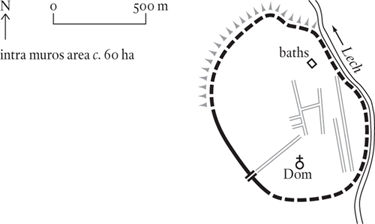
Bavaria, Germany
Classical Augusta Vindelicum; county town of the Vindelici, capital of Raetia in the early imperial period and of the late Roman province of Raetia Secunda
Roman Augsburg was situated on a hill overlooking the confluence of the Wertach and the Lech rivers. The site was chosen in around 15 BC during the period of the Augustan conquest of the region, when a legion was stationed at Oberhausen, on the far side of the Wertach. Initially Augsburg was merely the county town of the Vindelici, one of the more important of the Celtic tribes inhabiting northern Raetia, but when Raetia was made a province by Augustus in around 22 BC, it was chosen as the seat of the provincial governor. Although it lost the territory of the Valais during the reign of Claudius in AD 43, it retained its provincial government even after Marcus Aurelius, in the 170s, decided to station one of his new legions (III Italica) there. As the province’s senior official, the legion’s commander automatically became its governor, which normally would have meant that the legion’s camp at Regensburg (Castra Regina) would take over the role of provincial capital. This didn’t happen: the legion’s commander, most unusually, chose to live in Augsburg, rather than in his legion’s camp 130 kilometres (80 miles) to the north.
Around AD 300 the emperor Diocletian, as part of his mammoth reorganization of the empire, split Raetia into two halves, Raetias I and II. He also separated the military and civil administrations, which might have led to the dux, as the military commander was now known, finally making the move to Castra Regina. Once again this didn’t happen, however, and the dux stayed in Augsburg alongside his civilian counterpart. This situation continued as long as the empire lasted, which in this part of the world means the mid fourth century AD.
Our knowledge of the topography of Roman Augsburg is patchy, to say the least. The city’s outline is reasonably secure: the course of the city wall is preserved on the west side (along with a gate near the south-west corner). This, the contours of the hill and the course of the Lech on the east side suggest a perimeter roughly oval in shape, enclosing an area of about sixty hectares. Within this area a fair number of buildings have come to light, but only a set of baths in the north-east quarter of the town has been securely identified. It is permissible to assume that there is an early Christian basilica under the present-day cathedral. Of the theatre, amphitheatre and forum, there is no sign as yet. Nor is there any clearly discernible pattern in the roads and buildings that have been uncovered. Perhaps Roman Augsburg simply developed in an unplanned way within the ramparts of a pre-existing Celtic oppidum, but even so the lack of formality in a place that had a certain importance from its inception is surprising.
